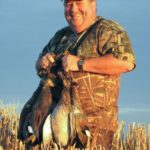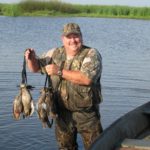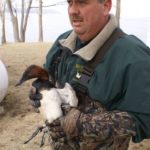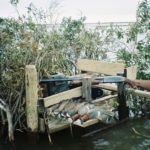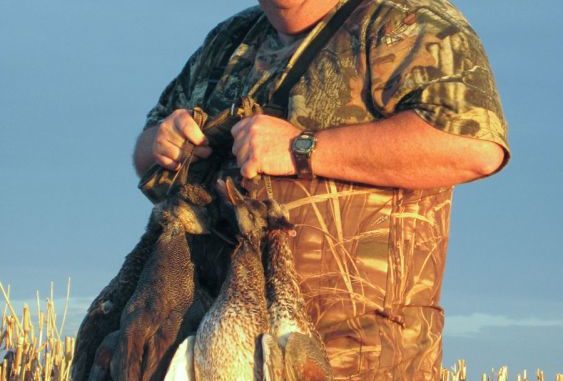
The state’s waterfowl study leader eats, breathes and sleeps ducks — on the job and in the blind. Learn Larry Reynolds’ top tips to shoot more birds this season.
Larry Reynolds is a man who wears two hats.
One is a perfect fit for the waterfowl study leader at the Louisiana Department of Wildlife and Fisheries — a position he’s held since 2008.
The other is his favorite camouflaged hunting cap: Reynolds has been an avid duck hunter since he was a 15-year-old kid growing up in Sacramento, Calif., pursuing gadwall, wigeon, pintail and green-winged teal on public lands in the Central Valley.
Now, the 56-year-old Baton Rouge resident heads up a section of four biologists at LDWF, and — in addition to conducting the state’s four annual aerial waterfowl surveys — Reynolds is largely responsible for crunching the numbers and proposing Louisiana’s duck hunting season dates to the Wildlife and Fisheries Commission each year.
The fact that he’s doing what he loves with ducks every day — both in his office as a biologist and in his blind in Cameron Parish as a hunter every duck season — isn’t lost on him.
“My parents told me, ‘It doesn’t matter what you do, you have to do what you love.’ And back in 1981, the only thing I loved as much as baseball was ducks and duck hunting …,” he said. “This job, this profession, this lifestyle — it’s not just what I do. It’s who I am.
“Ducks, duck management, duck regulations, duck hunting, duck hunters …. Ducks are what I’m all about 24/7. I wake up thinking about ducks and I go to sleep thinking about ducks.”
His unique perspective — as both a waterfowl enthusiast and a biologist with intimate knowledge of duck behavior — affords him the opportunity to head to his blind near Creole armed with more than just his trusty 1980 Remington 870 Wingmaster Magnum.
Reynolds understands the types of specific habitats ducks seek out as the season progresses, how the pairing process affects hunting success and — by flying thousands of miles every year during those aerial surveys — what flocks of birds actually look like on the landscape: Vital information in creating a realistic-looking decoy spread.
So he agreed to share three of his top tips so all Louisiana duck hunters can have a more successful season.
1. Be mobile — and flexible.
This one might be tough if you have a lease, but Reynolds said it’s important to understand why birds seek out different areas on the landscape as the season progresses — and why hunters should do the same.
“When birds first arrive early in the year, they’re not very well plumed out, so they’re looking for habitats that provide a variety of foods. In winter, they’re looking for energy to survive the cold temperatures, and they start flocking together,” he said. “But when they first get here, rice isn’t as important because it’s low protein. That’s why the marsh is so gangbusters early in the duck season because these birds are seeking out a habitat that provides submerged aquatic vegetation.
“One of the key values of SAVs early in the season is the host of protein-rich aquatic invertebrates and snails those SAVs harbor. So when you see a bunch of blue-winged teal in September, October and November feeding like crazy in SAVs, they’re not eating the leaves. They’re not eating the seeds. They’re not eating the rhizomes of the SAVs. They’re eating all the bugs and the snails that live in that submerged aquatic vegetation.”
Rice, on the other hand, is a high-energy carbohydrate — perfect for wintering ducks a little later in the season.
“That’s why you hear those guys in the rice fields that want to hunt later in the year,” he said. “Birds move around. Your lease might be terrific early in the season, but not so much late in the season — or vice versa.
“The main point is that because the nutritional requirements of ducks change from early-season to late-season, and because their behavior changes, primarily due to the pair bonding — hunters need to be mobile and they need to be flexible.”
For dabblers, their behavior changes when the pairing process begins, which typically starts happening in December.
“Once they pair, they’re not as social. That’s really important, because females are the limiting resource, so there’s competition for the females. So if you pair with a female, you’re not necessarily interested in exposing her to a bunch of other males that are trying to secure a mate for themselves,” Reynolds said. “That’s why we typically use smaller decoy spreads as the season gets later.
“So you need to be more particular about the habitats that you’re trying to lure these ducks to, and pairs are difficult to decoy to a large group of decoys because that male doesn’t want to expose that female to a lot more competition.”
Reynolds concedes that it’s somewhat difficult to be mobile if you have a lease in the marsh or in a rice field, but he does it every year.
“I apply for some of the hunts on public areas. I apply for the senior hunts at Cameron Prairie (National Wildlife Refuge.) I apply for the hunts at Mandalay National Wildlife Refuge, and we hunt diving ducks at Mandalay,” he said. “I’ve got my lease, but I also will go and hunt other places to try and take advantage of local abundance, changing habitat use and changing behavior.”
It’s a given that the ducks’ nutritional requirements and behavior will change as the season progresses. The key for hunters to be successful is to adapt to those changes, he said.
“If you’re doing the same thing at the end of the season that you’re doing at the beginning of the season, I think you’re going to be frustrated,” Reynolds said. “And we see that. We see when we do bag checks on our public hunting areas.
“You see the same guys doing the same things in the same places in the same way, and they struggle to be successful.”
2. Keep your decoy spread as realistic as possible.
When Reynolds conducts the aforementioned aerial surveys — covering thousands of miles from just 125 feet up while cruising at 100 knots — he sees, as you might imagine, lots and lots and lots of decoy spreads.
But the vast majority of them don’t even warrant a second look when he’s scanning the horizon trying to count birds — Reynolds knows instantly they’re not real ducks.
“When I can look at a decoy spread and go, ‘That doesn’t look like ducks,’ I gotta believe a duck does the same thing,” Reynolds said with a chuckle. “Hunters have to be aware of what ducks look like on the water. They don’t universally mix around, and they don’t sit in large regular groups. When I see regularity, I know it’s not ducks. Whenever there is a discernible pattern, I know it’s not ducks.
“Ducks don’t sit in a J, they don’t sit in an H and they don’t sit in two teardrops opposed to each other with a big lump on the levee between them.”
Instead, Reynolds suggested keeping your spread as realistic as possible by positioning decoys by species groups where they would naturally fit into the habitat you’re hunting.
“Occasionally, I’ll have to do a double take. I’ll look and then I’ll have to look again. Then I go, ‘Damn, that’s a great looking decoy spread.’ And when you see that, one of the things you’ll always see is irregularity. In other words, you don’t see two groups of decoys. You see 30 groups of decoys — 30 small groups that fit into the habitat scheme,” Reynolds said. “You don’t see a bunch of green-winged teal sitting in the wide open water, and a pile of gadwalls in the shallow spot to the left of the blind. What you see is decoys that fit the habitat scheme.
“You don’t see flocks on the landscape that are universally mixed. They stay in species-specific groups, but the groups mix up. You’ll see a group of wigeon in a pile of gadwalls, but what you’re looking at is 120 gadwalls with a group of 10 or 12 wigeon in the middle. Not 132 ducks with wigeon scattered throughout the flock. When I see a decoy spread where there’s a small group of mallards in one corner next to some emerging vegetation, and a group of 30 teal around the curvature of the shallow end of a pond, and a bunch of ring-necked ducks in a group out in the wide open water, that catches my attention because all of those things are realistic when I see birds on these aerial surveys.”
As for spinning-wing decoys, Reynolds says they definitely catch his eye when he flies the January survey while hunters are out in the field.
“When those spinning-wing decoys are on, I can see them for miles,” he said. “They really do look like ducks flapping their wings, so I can absolutely see why they attract ducks.”
But Reynolds uses a spinning-wing decoy only during teal season. If you feature one in your spread during duck season, he suggests using it in moderation via remote control.
“If they’re continuously spinning, you look at that and go, ‘That’s not realistic,’” he said. “They do it in a way that becomes predictable and overdone. My conclusion is that anyone that just uses a plain spinning-wing decoy for the entire season has definitely got to see a reduced response, and I think they’ll probably see avoidance of their spread late in the season.”
3. Keep your face hidden — really hidden.
This might seem like a no-brainer — one of the most basic duck-hunting rules that everyone has heard ever since first setting foot into a blind.
But Reynolds said said his experience flying the aerial survey reinforces just how much hunters’ faces stand out inside a blind on Louisiana’s dull winter landscape.
“Every January I’ll be flying along and looking at a blind and the hunter looks up at me, and it’s almost like somebody shining a spotlight in my eye,” Reynolds said. “Their face is so white and such a stark contrast to the cover of their blind, I actually laugh.”
While detractors might mock the Duck Dynasty guys for their beards and ‘poo faces,’ Reynolds said his aerial perspective definitely lends some credence to the practice.
“I tell you what, the way those guys that blacken their face — I never see them,” said Reynolds, who wears a light mesh face mask in his blind. “For all I know, they’re looking right at me from their blind through the cover.”
And remaining still in the blind is another key factor. From the air, Reynolds said movement catches his eye more so than a blind that’s not particularly well-brushed.
“There are some people that camouflage their pit blinds very narrowly, and it looks a lot more like the natural vegetation down the levee. Another thing a lot of guys do is they’re walking up and down that levee to get to their blind in a rice field, and they tromp all the vegetation on the levee except where they’re blind is and it looks really silly,” he said. “But most of the time if a blind is lightly or heavily brushed — if i don’t see movement — it looks fine.
“I’ve been surprised by that. And sometimes a blind that’s been lightly brushed that has some transparency to it rather than looking at this solid mass of stuff — it actually looks better.”
So like all Louisiana hunters, Reynolds is looking forward to yet another duck season — his 42nd in a blind. And while he’s completely aware this his job as waterfowl study leader doesn’t always make him the most popular biologist around, he understands he can’t please all the people all the time — but he still tries.
“Ducks are what I’m all about,” he said. “And I know there are people who think I’m the biggest idiot on the face of the earth, and they hate every decision I make and they hate every piece of logic I provide ….
“But my intentions are 100 percent toward the absolute success of waterfowl populations and duck hunter satisfaction.”
